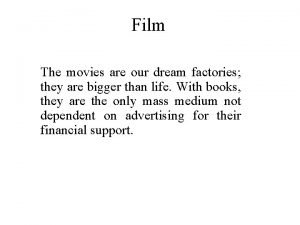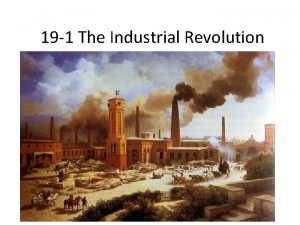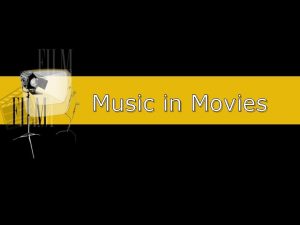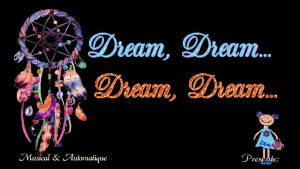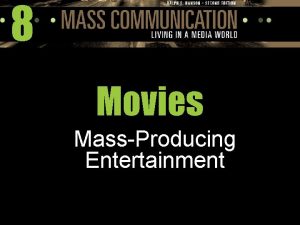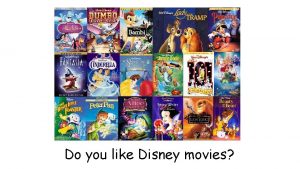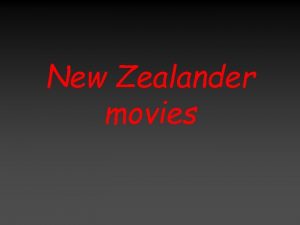Film The movies are our dream factories they





































- Slides: 37

Film The movies are our dream factories; they are bigger than life. With books, they are the only mass medium not dependent on advertising for their financial support.

That means they must satisfy you, because you buy the tickets.

This means that the relationship between medium and audience is different from those that exist with other media.

History • Early newspapers were developed by businesspeople and patriots for a small, politically involved elite that could read, but the early movie industry was built largely by entrepreneurs who wanted to make money entertaining everyone.

• Unlike television, whose birth and growth were predetermined and guided by the already well-established radio industry, there were no precedents, no rules, and no expectations for movies.

• The audience for the first Lumiére movies did not “speak film”. It as being stranded in a foreign country with no knowledge of the language and cultural conventions.

• First you’d learn some simple words and basic customs. Eventually, you’d be able to better understand the language and people. In other words, you’d become increasingly literate in that culture.

• Beginning with that Paris premiere, people had to become film literate. They had to develop an understanding of cinematic alterations in time and space.

• They had to learn how images and sound combined to create meaning. But unlike visiting in another culture, there was no existing cinematic culture. Movie creators and their audiences had to grow up together.

• They were shot in fixed frame (the camera did not move), and there was no editing. For the earliest audiences, this was enough.

• Georges Méliés began making narrative motion pictures, that is, movies that told a story.

• At the end of the 1890 s he was shotting and exhibiting one-scene, one-shot movies, but soon he began making stories based on sequential shots in different places.

• Méliés is often called the “first artist of the cinema” because he brought narrative to the medium in the form of imaginative tales such as A Trip to the Moon(1902).

• An Edison Company cameraman, saw that film could be an even better storyteller with more artistic use of camera placement and editing.

Change Comes To Hollywood • As was the case with newspapers and magazines, the advent of television significantly altered the movie - audience relationship. But the nature of that relationship had been shaped and reshaped in the 3 decades between the coming of sound and the coming television.

1. The Talkies There is no confusion, however, about the impact of sound on the movies and their audiences. First, sound made possible new genres–musicals, for example.

Second, as actors and actresses now had to really act, performance aesthetics improved.

Third, sound made film production a much more complicated and expensive proposition.

2. Scandal The popularity of talkies, and of movies in general, inevitably raised guestions about their impact on the culture. 3. New Genres, New Problems (Great Depression)

4. Television When World War II began, the government took control of all patents for the newly developing technology of television as well as of the materials necessary for its production. 5. The Paramount Decision 6. Red Scare (Postwar position)

7. Fighting Back The industry worked mightily to recapture audiences from television using both technical and content innovations. Some of these innovations remain today and serve the medium and its audiences well.

• The movies as an industry had changed, but as a medium of social commentary and cultural impact, they may have grown up.

Movies and Their Audiences • We talk of Hollywood as the “dream factory, ”the makers of “movie magic”. We want our lives and loves to be “just like in the movies”.

• The movies are “larger than life”, and movie stars are much more glamorous than television stars.

• In this sense the movie - audience relationship has more in common with that of books than with that of television. Just as people buy books, they buy movie tickets. Because the audience is in fact the true consumer, power rests with it in film more than it does in television.

• For better or worse, today’s movie audience is increasingly a young one. A teenager or young adult.

Film Industry There are three component systems; Production (Making film) Distribution Exhibition

Review • Film’s beginnings reside in the efforts of entrepreneurs such as Eadweard Muybridge and inventors like Thomas Edison and William Dickson.

• Photography, an essential precursor to movies, was developed by Hannibal Goodwin, George Eastman, Joseph Nicéphore Niépce, Louis Daguerre, and William Henry Fox Talbot.

• Edison and the Lumiére brothers began commercial motion picture exhibition, little more than representations of everyday life. George Méliés added narrative; Edwin S. Porter added montage; and D. W. Griffith developed the full-lenght feature film.

• Movies became big business at the turn of the 20 th century, one dominated by big studios, but change soon came in the form of talkies, scandal and control, and new genres to fend off the Depression.

• The three components of the film industry are production, disribution, and exhibition.

• Studios are at the heart of the movie business and are increasingly in control of the three component systems. There are major, corporate independent, and independent studios.

• Conglomeration and concentration affect the movie industry, leading to a blockbuster mentality.

• Convergence, too, is reshaping the industry, promising to alter its structure and economics.

• Media literate moviegoers should be aware of the inclusion of product placements in films and their potential influence on the medium.

 Antigentest åre
Antigentest åre Movies about factories
Movies about factories Types of imagery in poetry
Types of imagery in poetry To dream the impossible dream poem
To dream the impossible dream poem Explain wedge film and squeeze film journal bearings
Explain wedge film and squeeze film journal bearings My dream school ideas
My dream school ideas Hold on to our dream
Hold on to our dream Favourite tv channel
Favourite tv channel Christ be our light
Christ be our light Money madness notes
Money madness notes Our life is what our thoughts make it
Our life is what our thoughts make it Our future is in our hands quotes
Our future is in our hands quotes Marcus aurelius our life is what our thoughts make it
Marcus aurelius our life is what our thoughts make it Awareness of ourselves and our environment is:
Awareness of ourselves and our environment is: Thinking affects our language which then affects our
Thinking affects our language which then affects our Our awareness of ourselves and our environment
Our awareness of ourselves and our environment We bow our hearts we bend our knees
We bow our hearts we bend our knees Our awareness of ourselves and our environment is called
Our awareness of ourselves and our environment is called Our census our future
Our census our future Is our awareness of ourselves and our environment.
Is our awareness of ourselves and our environment. Our census our future
Our census our future God our father christ our brother
God our father christ our brother Honey bee wax glands
Honey bee wax glands Husky injection molding machine factory
Husky injection molding machine factory Rammable refractory factories
Rammable refractory factories Sic whiskers factories
Sic whiskers factories Factories act 1948 notes
Factories act 1948 notes Hydraulic can crusher project
Hydraulic can crusher project Factorisation
Factorisation Jiatong factories
Jiatong factories Fumes from factories
Fumes from factories Elcb working
Elcb working Indian factory act
Indian factory act Self inductance of coil formula
Self inductance of coil formula Water powered factories
Water powered factories 1 seg factories
1 seg factories Kookaburra nest factories
Kookaburra nest factories Glass fused steel tanks
Glass fused steel tanks

